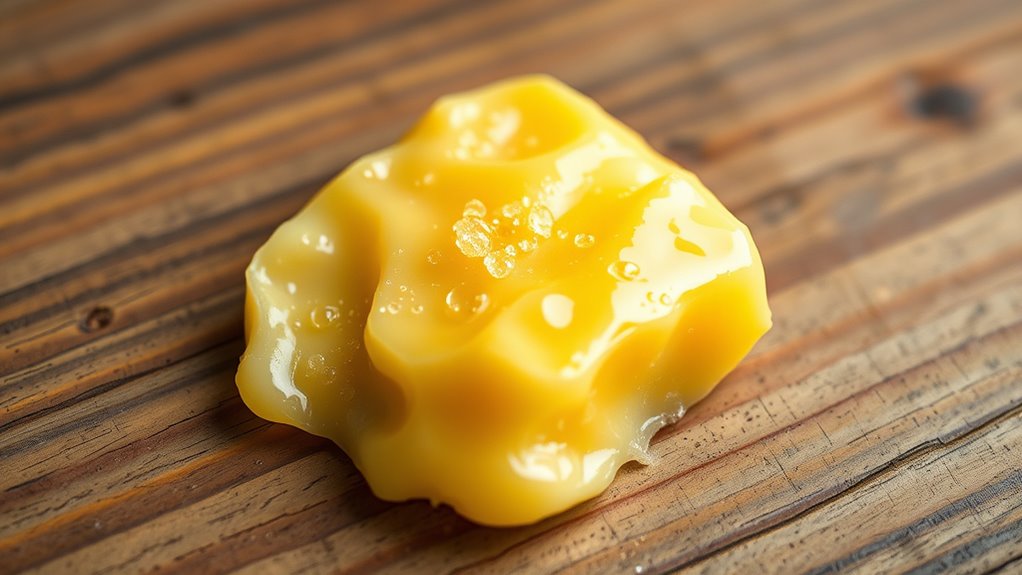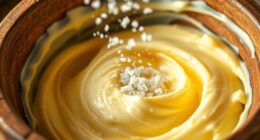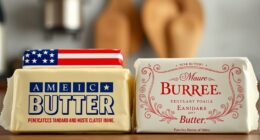Enzyme-aged butter uses specific enzymes to rapidly develop complex flavors in just 24 hours, cutting down traditional aging from weeks. By controlling conditions like temperature and humidity, you can accelerate biochemical reactions that break down fats and proteins, creating rich, layered tastes quickly. This method offers consistency, efficiency, and new culinary possibilities. If you keep exploring, you’ll discover how this innovative process can transform your dairy creations and elevate your flavor game.
Key Takeaways
- Enzymes catalyze biochemical reactions that develop complex flavors traditionally achieved over weeks, now accelerated to 24 hours.
- Precise control of temperature, humidity, and enzyme selection ensures targeted breakdown of fats and proteins for flavor development.
- Microbial or plant-derived enzymes enable rapid fermentation, mimicking natural aging processes in a fraction of the time.
- Enzyme‑aged butter offers intensified, complex flavors suitable for culinary applications like sauces, spreads, and cheese rinds.
- Advances in enzymatic technology facilitate fast, predictable dairy aging, supporting innovation and sustainability in dairy production.
Understanding the Role of Enzymes in Dairy Aging
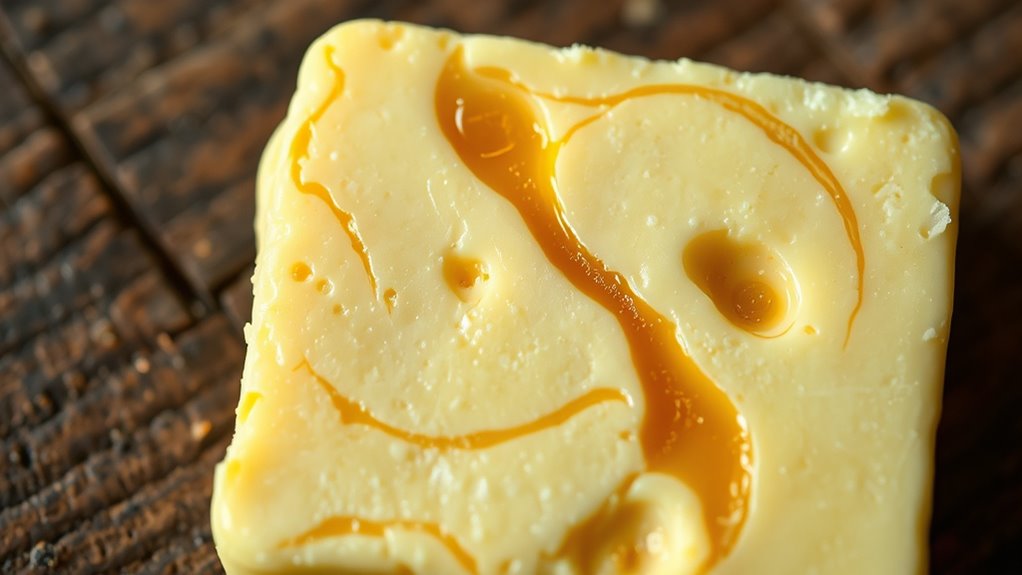
Enzymes play a crucial role in the aging process of dairy products, acting as natural catalysts that drive chemical changes over time. During microbial fermentation, specific enzymes target particular molecules, thanks to their enzyme specificity. This precision ensures that only certain fats, proteins, or sugars break down, creating complex flavors and textures in butter. As microbes produce these enzymes, they influence the development of aroma, taste, and consistency in aged dairy. Your understanding of enzyme specificity helps explain how precise biochemical reactions occur, transforming fresh dairy into a more flavorful product. By controlling fermentation conditions, you can harness these natural processes, accelerating aging without sacrificing quality. This targeted enzymatic activity is key to developing the rich, nuanced profiles characteristic of traditionally aged dairy products. Enzyme specificity enables targeted breakdown of dairy components, leading to more refined flavor development.
The Science Behind Accelerated Flavor Development
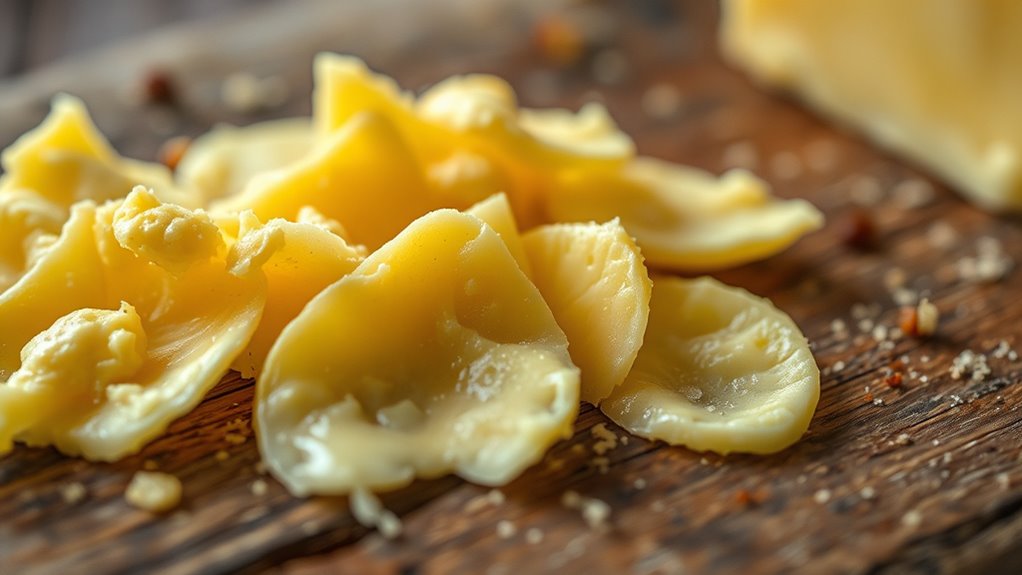
Accelerated flavor development in aged butter relies on carefully controlling enzymatic activity to speed up the natural aging processes. Enzymatic fermentation is key, as specific enzymes break down fats and proteins, producing complex flavor compounds rapidly. This process enhances flavor catalysis, where enzymes facilitate chemical reactions that create savory, nutty, and umami notes in just 24 hours. By managing temperature, pH, and enzyme levels, you optimize these reactions, ensuring consistent and intense flavor profiles. The enzymes act as catalysts, transforming the butter’s molecules swiftly, mimicking weeks of traditional aging. Vetted – Mother Baby Kids This scientific approach allows you to harness natural biochemical processes efficiently, resulting in a deeply flavored, complex butter in a fraction of the usual time.
Step-by-Step Process of Creating Enzyme‑Aged Butter
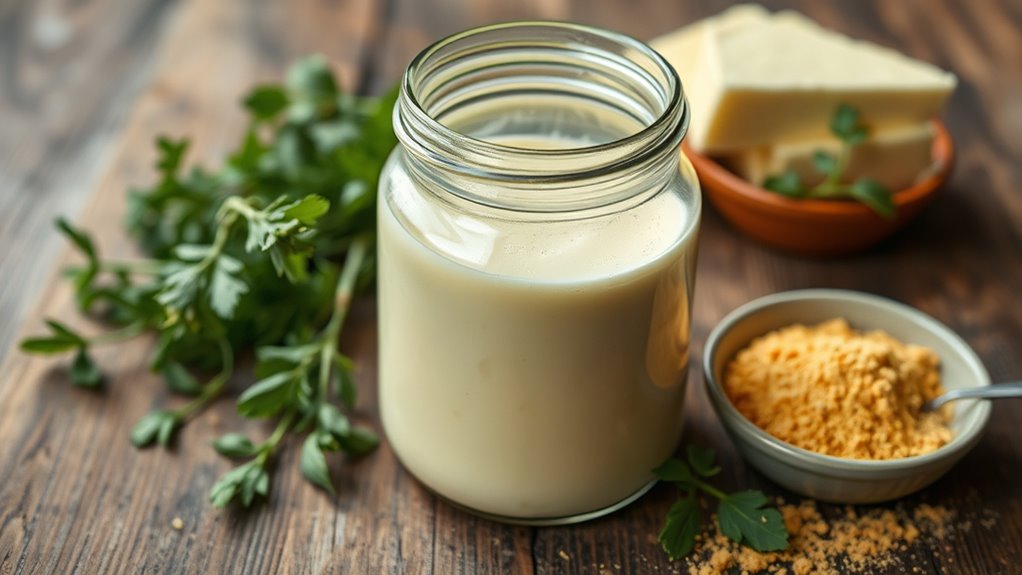
To create enzyme-aged butter, you start by selecting the right enzymes that will develop the desired flavors. Next, you control the aging conditions carefully to guarantee consistent results. Establishing clear documentation of each step ensures traceability and quality control throughout the process. Following these steps, you’ll produce butter with enhanced depth and complexity.
Subheading 1: Selecting Suitable Enzymes
Choosing the right enzymes is vital to successfully creating enzyme-aged butter. You need to select enzymes that effectively break down fats and proteins, enhancing flavor development within 24 hours. Focus on enzyme sources like microbial or plant-derived enzymes, which are reliable and safe for food processing. Consider fermentation techniques that optimize enzyme activity, guaranteeing they work efficiently at your desired temperature and pH. Using high-quality enzyme sources ensures consistent results and minimizes unwanted flavors. It’s imperative to match enzyme types to your butter’s base ingredients, enabling controlled breakdown of complex compounds. Enzyme stability plays a crucial role in maintaining activity during the aging process. By carefully selecting suitable enzymes, you set the foundation for a flavorful, complex butter that develops richness rapidly through precise enzymatic action.
Subheading 2: Controlled Aging Conditions
After selecting the appropriate enzymes, establishing precise aging conditions guarantees the desired flavor development in your butter. You need to control temperature, humidity, and time carefully to promote microbial fermentation without overdoing it. Maintaining a stable environment encourages beneficial microbes to break down fats and proteins, enhancing flavor complexity. This process also allows for texture modification, resulting in a creamier, richer butter. Consistent conditions prevent unwanted microbial growth that could spoil the product. Use a dedicated aging chamber or a controlled space to monitor these parameters closely. By fine-tuning these factors, you ensure that enzymatic reactions proceed uniformly, leading to a balanced, nuanced butter after just 24 hours. Properly managed aging conditions are key to achieving complex flavors and ideal texture in your enzyme-aged butter. Additionally, understanding fitness hours today can help you plan your own routine around optimal times for relaxation and rejuvenation after your culinary experiments.
Comparing Traditional and Enzyme‑Aged Butter

You’ll notice that enzyme‑aged butter often has a richer, more complex flavor compared to traditional butter. It also takes less time to produce, allowing for quicker turnaround. Exploring these differences helps you understand how processing methods impact both taste and efficiency. Mindful decluttering practices can help streamline your kitchen space, making the process of creating different types of butter more organized and efficient.
Flavor Development Differences
Have you ever wondered how different aging methods influence the flavor of butter? Traditional aging relies on natural fermentation techniques, allowing complex microbial interactions that develop deep, nuanced flavors over time. This slow process enhances flavor profiling with subtle earthy, nutty, and tangy notes. In contrast, enzyme-aged butter speeds up fermentation through added enzymes, accelerating flavor development within 24 hours. This rapid method produces a different profile—often more intense, with sharper, more concentrated tastes. The enzymatic process breaks down fats and proteins quickly, creating unique flavor compounds that traditional methods take weeks to develop. Additionally, fermentation techniques influence the complexity of flavors, with rapid enzyme methods providing a bold alternative. As a result, enzyme-aged butter offers a distinct sensory experience, combining the familiar richness of butter with bold, complex notes that would otherwise require much longer aging.
Production Time Variations
Traditional aging of butter typically takes several weeks, relying on natural fermentation processes that gradually develop complex flavors. During this period, fermentation timing varies based on temperature and microbial activity, making the process lengthy and less predictable. In contrast, enzyme‑aged butter markedly reduces this timeframe by carefully selecting specific enzymes that accelerate flavor development. With enzyme selection, you can control the reaction speed, allowing aging to occur in just 24 hours. This method bypasses the slow natural fermentation, providing consistent results and faster production cycles. While traditional aging depends on spontaneous microbial activity, enzyme‑induced aging offers precision and efficiency, making it an attractive option for producers seeking rapid flavor complexity without sacrificing quality. Understanding breed characteristics can also help optimize the aging process by tailoring flavors to specific breeds’ profiles.
Applications and Culinary Uses of Enzyme‑Aged Butter
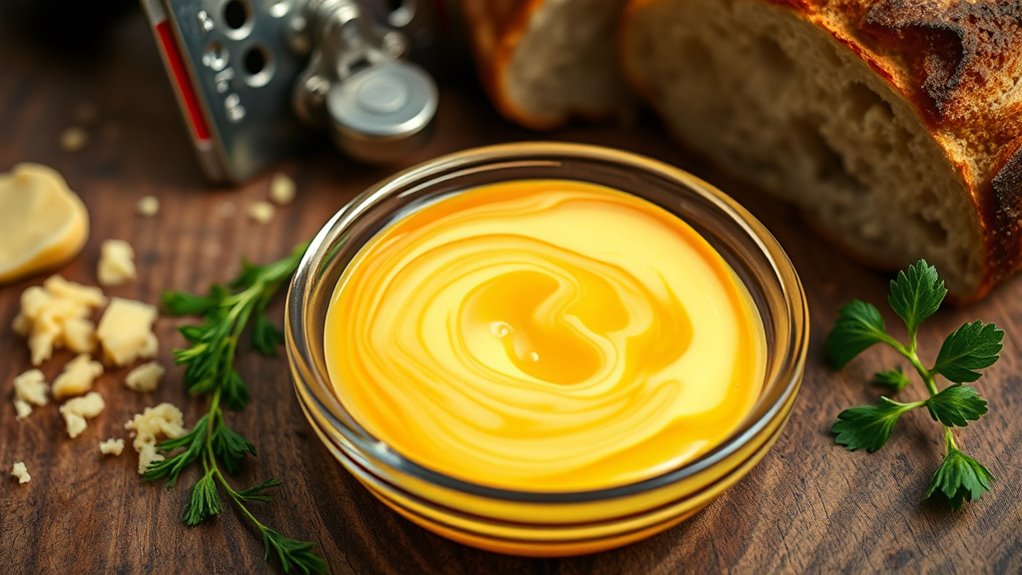
Ever wondered how enzyme-aged butter can elevate your culinary creations? Its rich, complex flavors make it perfect for cheese ripening and enhancing dishes. You can use it to finish sauces, deepen baked goods, or create flavor-rich spreads. Its unique profile results from accelerated fermentation techniques, giving you aged flavor in just 24 hours. Imagine the following flavor layers:
| Dish Type | Flavor Enhancement | Best Pairings |
|---|---|---|
| Cheese Rind | Intensifies umami and tang | Fresh bread, fruits |
| Sauces | Adds depth and complexity | Grilled meats, vegetables |
| Baked Goods | Enhances aroma and richness | Crusty bread, pastries |
| Spreads | Creates savory, aged notes | Crackers, charcuterie |
This butter unlocks rapid innovation, allowing you to experiment with fermentation techniques and elevate classic dishes effortlessly. Understanding the fermentation process can help you better appreciate how these flavor profiles develop so quickly.
Future Perspectives in Rapid Dairy Maturation
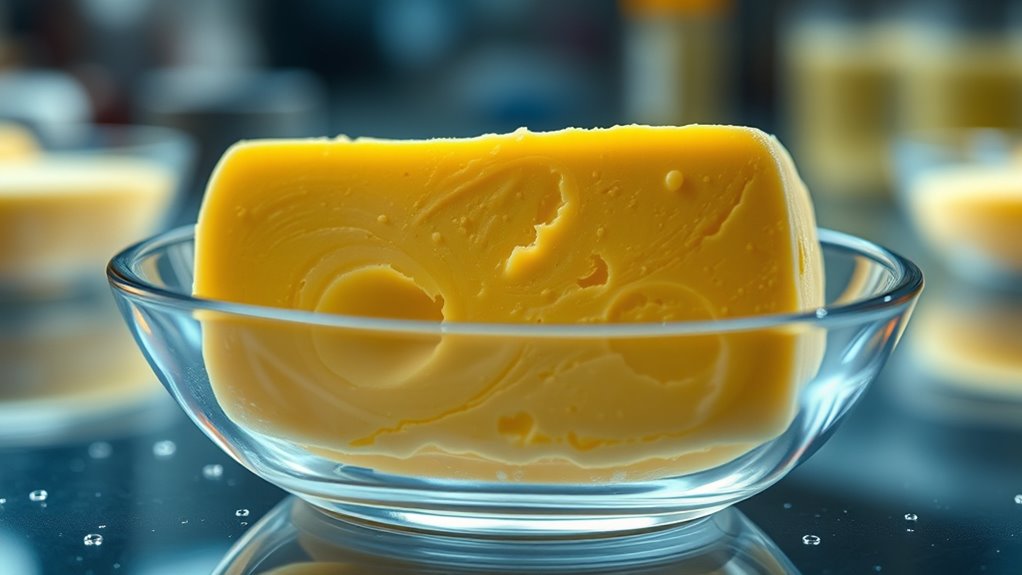
Advancements in rapid dairy maturation are poised to revolutionize how producers and chefs approach cheese and butter aging. Enzymatic catalysis plays a central role, enabling precise control over flavor development within hours instead of months. Future techniques will likely harness targeted dairy fermentation, accelerating complex biochemical reactions that traditionally take time. Innovations may include custom enzyme blends that speed up proteolysis and lipolysis, creating richer, more nuanced profiles rapidly. This progress will also reduce waste and optimize resource use, making high-quality aged dairy products more accessible. As research continues, expect to see smarter, more sustainable methods that combine enzymatic catalysis with advanced fermentation control, transforming dairy processing into a faster, more consistent art. These breakthroughs will also facilitate personalized dairy products, catering to individual tastes and dietary needs. This evolution will open new culinary possibilities and redefine dairy product timelines.
Frequently Asked Questions
How Does Enzyme-Aged Butter Compare in Nutritional Value to Traditional Butter?
You might wonder how enzyme-aged butter compares nutritionally to traditional butter. While both provide fats and calories, enzyme aging can enhance flavor complexity, making it richer and more nuanced. Some studies suggest that enzyme processes may slightly improve digestibility and preserve certain nutrients, but overall, their nutritional benefits are similar. The main difference lies in flavor enhancement, giving enzyme-aged butter a unique taste experience without considerably altering its nutritional profile.
Are There Any Health Risks Associated With Consuming Enzyme‑Aged Butter?
You might be surprised to learn that enzyme-aged butter could pose some health risks, especially if you have allergies or sensitivities. While it’s crafted to enhance flavor, allergy concerns remain, so watch out for reactions. Microbial safety is also essential; improper aging could introduce harmful bacteria. Always make sure it’s produced under strict conditions, and consult your doctor if you’re unsure. Staying informed helps you enjoy new foods safely.
Can Enzyme‑Aged Butter Be Produced at Home Easily?
Making enzyme‑aged butter at home is possible, but it requires some DIY fermentation skills. You’ll need basic kitchen equipment like a jar, thermometer, and possibly a fermentation vessel. While it’s not overly complex, you should follow a detailed recipe and guarantee proper sanitation to avoid spoilage. With patience and careful handling, you can produce enzyme‑aged butter in your own kitchen, enjoying its unique flavors.
What Are the Environmental Impacts of Accelerated Dairy Aging Processes?
You might wonder about the environmental impacts of accelerated dairy aging processes. By adopting sustainable practices, you can minimize energy use and reduce waste generated during production. Speeding up aging can decrease the time and resources needed, leading to waste reduction and a smaller carbon footprint. This approach helps make dairy processing more eco-friendly, aligning with efforts to protect the environment while enjoying complex flavors in less time.
How Long Does Enzyme‑Aged Butter Stay Fresh Compared to Traditional Butter?
Like a fine wine aging gracefully, enzyme‑aged butter often stays fresh longer than traditional butter, thanks to its unique fermentation process. Its shelf life can extend up to several weeks with proper storage techniques, such as keeping it in an airtight container and refrigerating consistently. This controlled aging enhances flavor complexity while maintaining freshness, giving you more time to enjoy its rich, nuanced taste compared to standard butter.
Conclusion
By embracing enzyme-aged butter, you unlock a flavor revolution that defies time itself. In just 24 hours, you transform ordinary dairy into an extraordinary masterpiece, unleashing a symphony of complex, layered tastes. This isn’t just quick aging—it’s a culinary breakthrough that rewrites what’s possible in flavor development. So, dare to push boundaries, because with enzyme-aged butter, you’re not just speeding up the process—you’re rewriting the future of dairy craftsmanship.
